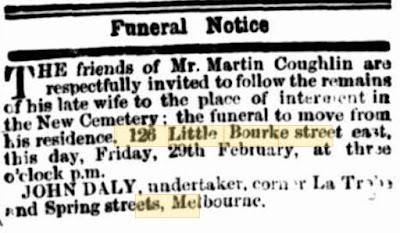The plan above shows the Duck Holes Hotel on the Lancefield Rd, to the right of the image. The "New school house" (written upside down on the plan) is on the other side of the Duck Holes Creek, to the left of the hotel. VPRS 61/P0/1848.Duck Holes was a tiny settlement on the Lancefield Rd in the Parish of Monegeetta in Victoria. The growing number of children needing an education prompted locals to set up a Church of England School. In 1861 they wrote to the Denominational Schools Board seeking a salary for the teacher. At this time the school was already being conducted in a private home, but a new school house would be completed within two to three weeks. The application included a list of students and a drawing of the school and surrounds (shown above), as required. The teacher salary was granted. Bob Mackay, a friend of mine, was doing a trawl through the Denominational Schools Board correspondence at PROV, and as was his usual practice, ran his eye over the list of pupils - and spotted a surname he recalled as being of interest to me - Hitchman.
Denominational Schools Board, Inwards Registered Correspondence, VPRS 61/P0/ 1848. Application for funding for a teachers' salary, 1 July 1861.
The 1859 Duck Holes Hotel, 2015. The farmer on whose land the hotel stands covered the hotel in corrugated iron some years ago for the safety of his children. Courtesy of Margaret Fleming.
There is not a lot left now at Monegeetta, the former Duck Holes. Miraculously the Duck Holes Hotel built in 1859, has survived to this day, though no longer operating. I think we would be safe in saying that James Hitchman senior had a cooling ale on his way home from work and 'never ever ever got rollin' drunk'. (Probably).
Duck Holes Rd crossing Duck Holes Creek in 2015. Courtesy of Margaret Fleming.
The Duck Holes Hotel was built in 1859, but the earliest known licence was from 1862. The school, established as a Church of England Denominational School, first applied for government funding for a teachers' salary in July 1861, but it was already operating in a private house by that time. The application, made by the Rev John B Stair of Broadmeadows, explained that a 30 X 15 feet schoolroom was in the course of construction. The hotel and the nearby school became the central point for community activity.
Duck Holes Hotel, Argus 11 Apr 1868
The name Duck Holes was given to the area owing to the ducks attracted to the crabholes and ponds which formed the Duck Holes Creek.
When the government defunded Denominational Schools in 1863, forcing many of them to close, schools that were more than two miles from an existing government school continued on as Common Schools. Duck Holes School survived because the nearest school was Bolinda, four miles away. Duck Holes then acquired the number 201. It was later renamed Monegeetta North.
Margaret Fleming (who supplied photos and information about Duck Holes) and I met as volunteers at the Royal Historical Society of Victoria some 160 years after our great grandfathers went to school together at Duck Holes.
Sources:
Pioneer brothers: Henry and John Muller: their heritage and descendants, 1715 -2015, by Margaret Fleming and Marie Dickson, 2015.
PROV: VPRS 61/P0/1848.
Trove
Wikipedia: Monegeetta, Victoria.












